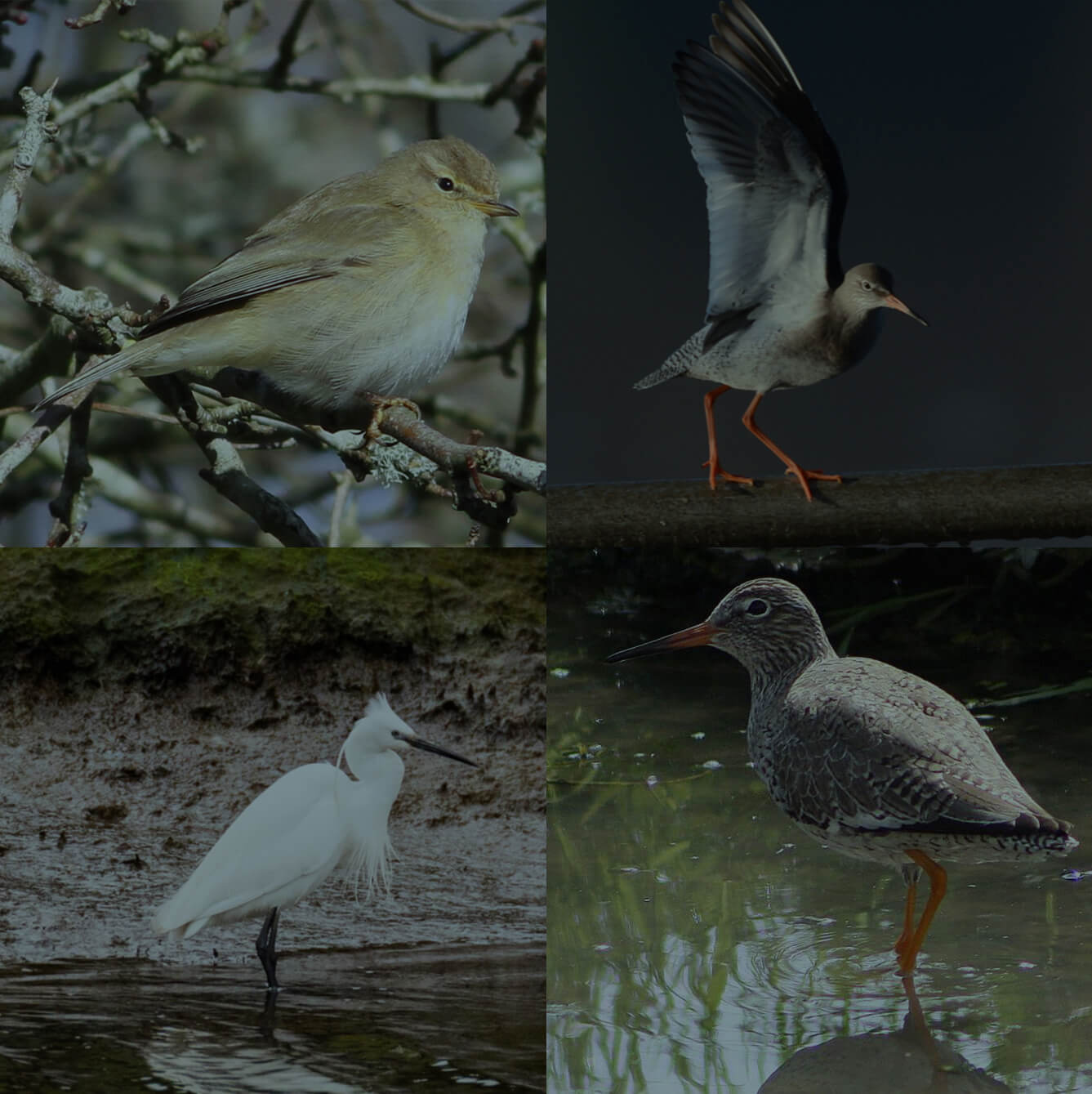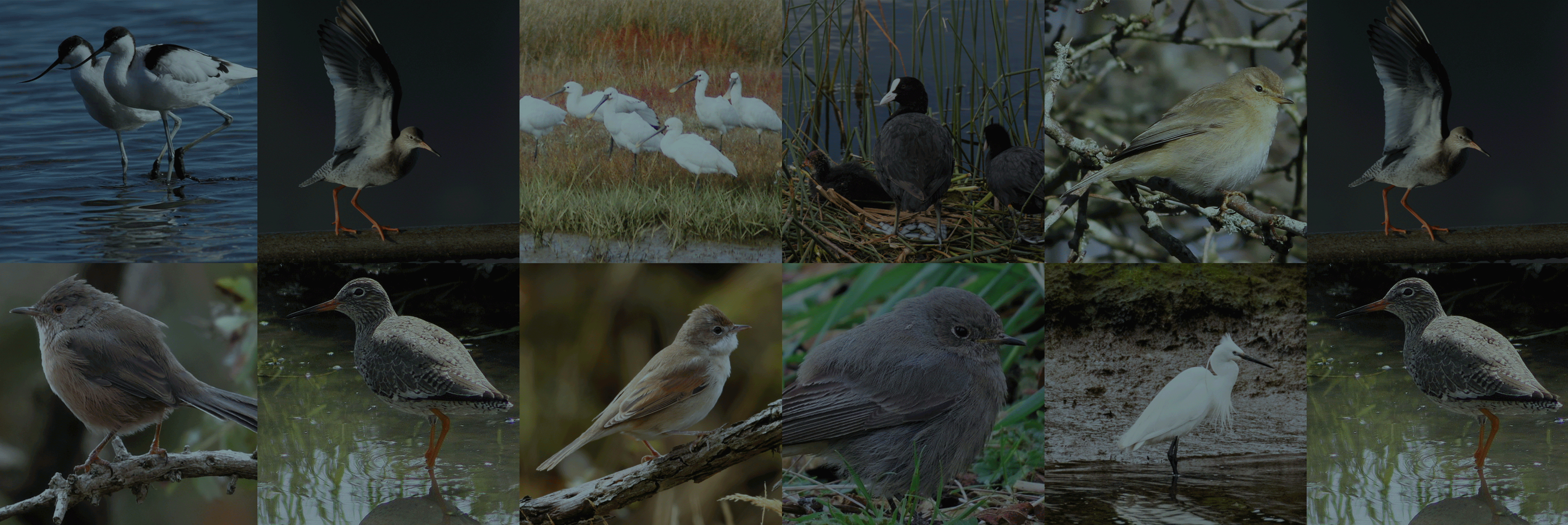An official account of all species that have been recorded and reported by birdwatchers and naturalists in the Poole Harbour area since records began.
The data for this list has been extracted from various sources, but George Greens 'The Birds of Dorset', Mansel-Pleydell's Birds of Dorsetshire, Naylor’s reference manual of rare birds and the back catalogue of Dorset bird reports have provided most information. Data is currently still being researched and records will be updated accordingly.
You can view this information in two different ways. Our alphabetical list provides information on the status of each species within the harbour, finder dates and names, photos and favoured locations. By clicking on the Systematic List button you will be presented the full Poole Harbour systematic list which includes status of species, pending records and historical accounts.
To date, 333 species have occurred and have been accepted within the Birds of Poole Harbour boundaries. A further 11 distinct subspecies have also been seen. In addition, we have two species/subspecies which have been recorded, but are awaiting acceptance by the appropriate records panel.
There are a handful of historical records, for which there is currently insufficient information to allow their inclusion onto the Poole Harbour list, but are believed to be genuine records. They are listed at the end of the list.
Finally, there are a number of feral or escaped species that have been recorded within the Birds of Poole Harbour boundaries. They are included for completeness, but are not included on the Poole Harbour list.
We would be interested in hearing details of any species that do not appeared on this list.
The Birds of Poole Harbour systematic list is a PDF which you can view by clicking on the button below. It was last updated on December 2019.
Full Poole Harbour Systematic List
Olive-backed Pipit
Latin Name
Anthus hodgsoni
Status
Vagrant
Site And Records Information
Ballard Down 1 on 12th Oct 2015 (Nick Hopper, Paul Morton). Identified only from a sound recording made during a visible migration watch, this constitutes Dorset’s first away from Portland.
Ortolan Bunting
Latin Name
Emberiza pusilla
Status
Vagrant
Site And Records Information
Prior to 2015 there had only been one record of Ortolan Bunting within the Poole Harbour area.
1 on 4th Sept 2007 Glebelands, Studland (N.Hopper)
Then in 2015 sound recording efforts at prominent migration spots such as Glebelands and Ballard Down produced another record of one passing by with Linnet.
1 sound recorded on Sept 19th 2015 Glebelands, Studland (P.Morton)
Then, in 2016 everything changed with the setting up of a nocturnal listening station in Old Town Poole where the monitoring of night-time migrants could be accurately assessed on a nightly basis during peak migration times. As autumn migration got under way big movements of Tree Pipit and wader species were a nice insight as to what was going on above our heads whilst we were sleeping, but the most incredible discovery came along at 2:24am on August 23rd when an Ortolan Bunting passed over the listening station. Its well documented that Ortolan Bunting are a vocal night time migrant in mainland Europe, within their range. But over Poole Town Centre? Over the following 21 nights another TWELVE Ortolan Bunting were recorded migrating over the listening station bringing the total to 13. Dates Ortolan Bunting were recorded flying over the nocturnal listening station were…..
1 on 23rd August 2016 @ 2:47am
1 on 24th August 2016 @ 2:00am & 2:40am
1 on 25th August 2016 @ 1:31am, 2:27am & 3:08am
1 on 27th August 2016 @ 2:03am
1 on 29th August 2016 @ 9:37pm
1 on 30th August 2016 @ 3:34am
1 on 1st September 2016 @ 2:33am
1 on 5th September 2016 @ 8:53pm
1 on 7th September 2016 @ 2:46am
1 on 12th September 2016 @ 1:12am
The discovery was made in partnership with the Sound Approach and a full write up of the discovery can be found on the Sound Approach website titled Things that go Plink in the night
In addition to the night migration discovery another Ortolan Bunting was seen and heard flying along Soldiers Road on September 3rd 2016 at 8:10am
2017
Poole 3 sound-recorded at night on 3rd Sep.
2018
Lytchett Bay 1 nocturnal migrant at 2300 on 27th Aug (P Morton).
2019
Corfe Castle Single nocturnal migrants heard over Corfe Gap on 21st & 27th Aug (P Morton).
2020
Stoborough 1 nocturnal migrant on 26th Aug (Nick Hopper).
2021
1 on 5th Sept 2021 ‘noc-migged’ over Lytchett Bay (N.Hull)
Osprey
Latin Name
Pandion haliaetus
Status
Passage Migrant
Site And Records Information
Several Ospreys will generally pass through the harbour area in spring and individuals may even linger for part of the summer, but they are most easily seen during autumn (Jul-Sept) when up to ten may be present simultaneously during the peak migration time of mid-August to early September. They can then be seen feeding or resting in favoured locations, notably at the back of the Middlebere Channel or the Wareham Channel where two-four may be present together. Alternative day roost sites include Morden Bog (just outside the Harbour boundary), Lytchett Bay, Holton Heath and private grazing land at Keysworth.
Ospreys fish in open water all around the harbour though they are most often seen off the Arne Peninsula or in the Wareham Channel. There are also annual records of birds fishing in Brands Bay and Wytch Lake in addition to all of the above sites.
Several artificial nests were erected within the Harbour in 2010 by the RSPB under the expert guidance of Roy Dennis. It was hoped that nesting would occur in due course but, although birds have been recorded on the nest platforms, no indication of breeding has yet been observed.
The earliest date on record is on 7th Mar 2007 at Arne and the latest is 30th Nov 2001 at Holes Bay. These are also the earliest and latest dates for Dorset.
In July 2017 an Osprey translocation was given the go ahead to take place in Poole Harbour as a first stage in establishing a south coast breeding population of this spectacular bird. The project was led by us, ‘Birds of Poole Harbour’, Scottish charity the ‘The Roy Dennis Wildlife Foundation’ and local Poole based-business ‘Wildlife Windows’. Over a five year period (2017-2021) 60 Osprey chicks will be translocated from Scotland to Poole Harbour in an effort to restore a south coast breeding population.
Ospreys, which feed exclusively on fish, historically bred across the whole of Britain and NW Europe; but populations drastically declined in the Middle Ages and became extinct in England by the mid 1800’s. The five year project looks to restore Ospreys to their former breeding grounds in the south of England where they used to have the local nickname “Mullet Hawk”. At the same time the project will provide an important stepping stone between breeding populations in Britain and northern France, with the aim of enhancing the long term survival of the Western European population as a whole. The project is part of a wider conservation recovery plan of Osprey in Western Europe and the Mediterranean region.
A Conservation Recovery Plan
Ospreys are annual visitors to Poole Harbour as they pass through on their northward and southward migrations between their breeding grounds in Scotland and central England and their over-wintering grounds in West Africa. Over the last 8 years, efforts within Poole Harbour have been made by the RSPB, Natural England, The Forestry Commision, The National Trust and private landowners to try and attract Osprey to stay and breed by erecting artificial nesting platforms in the hope that the birds will adopt them as their own nests. Osprey are semi-colonial and often choose to nest in areas where other Osprey are nesting and in 2009, the RSPB went as far as placing decoy birds, supplied by Roy Dennis, on one of their nesting platforms on their Arne Reserve. Although there has been some interest by Osprey in these nesting platforms over that 8 year period, none have decided to stay and breed and it’s now thought a translocation project is the next logical step to try and encourage these incredible birds of prey to settle on the south coast of England.
Previous Restoration Success
Translocation has proved a highly successful means by which to restore ospreys to areas from which they have been lost. The much-admired population at Rutland Water in the East Midlands was established by a pioneering translocation project in the late 1990s and similar work has since taken place in two regions of Spain as well as in Italy, Portugal and Switzerland.
This pan-European experience means that the Poole Harbour project, which will involve licensed collection of five-six week-old chicks from healthy, sustainable populations in Scotland, has the best-possible chance of success. Once collected the chicks will be safely brought down to Poole Harbour and held in large holding pens at a confidential site for just two – three weeks to acclimatise to their new home and prepare for their first flights. Once released they will be provided with fresh fish on artificial nests, to replicate normal osprey behaviour, and so are likely to remain around Poole Harbour for a further six weeks (the normal post-fledging period) before beginning their long migration to West Africa. During this six week period the birds will imprint on the area and adopt Poole as their new home.
Breeding
In 2022, the first breeding of Osprey in southern Britain for 200 years was achieved as a direct result of the Translocation that the Birds of Poole Harbour and Roy Dennis Wildlife Foundation carried out. Osprey pair CJ7 (female) and 022 (male) nested at a confidential site in the Piddle Valley and successfully fledged 2 juvenile female Ospreys. These chicks were ringed 5H1 and 5H2. Sadly, almost a month after fledging, 5H2 was taken by a juvenile Goshawk at the nest site. Thankfully 5H1 successfully migrated away in late August 2022.
In 2023 the adult pair CJ7 and 022 safely returned from West Africa to their nest site in the Piddle Valley and began nest building straight away. The 2023 season was far more successful with 3 chicks being produced, ringed 5H3 (male), 5H4 (male) and 5H5 (female) all of which successfully migrated from the harbour at the end of August 2023.
Osprey – Brands Bay – Peter Moore
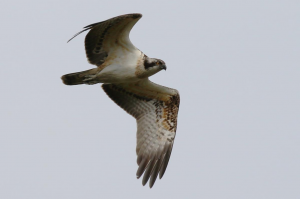
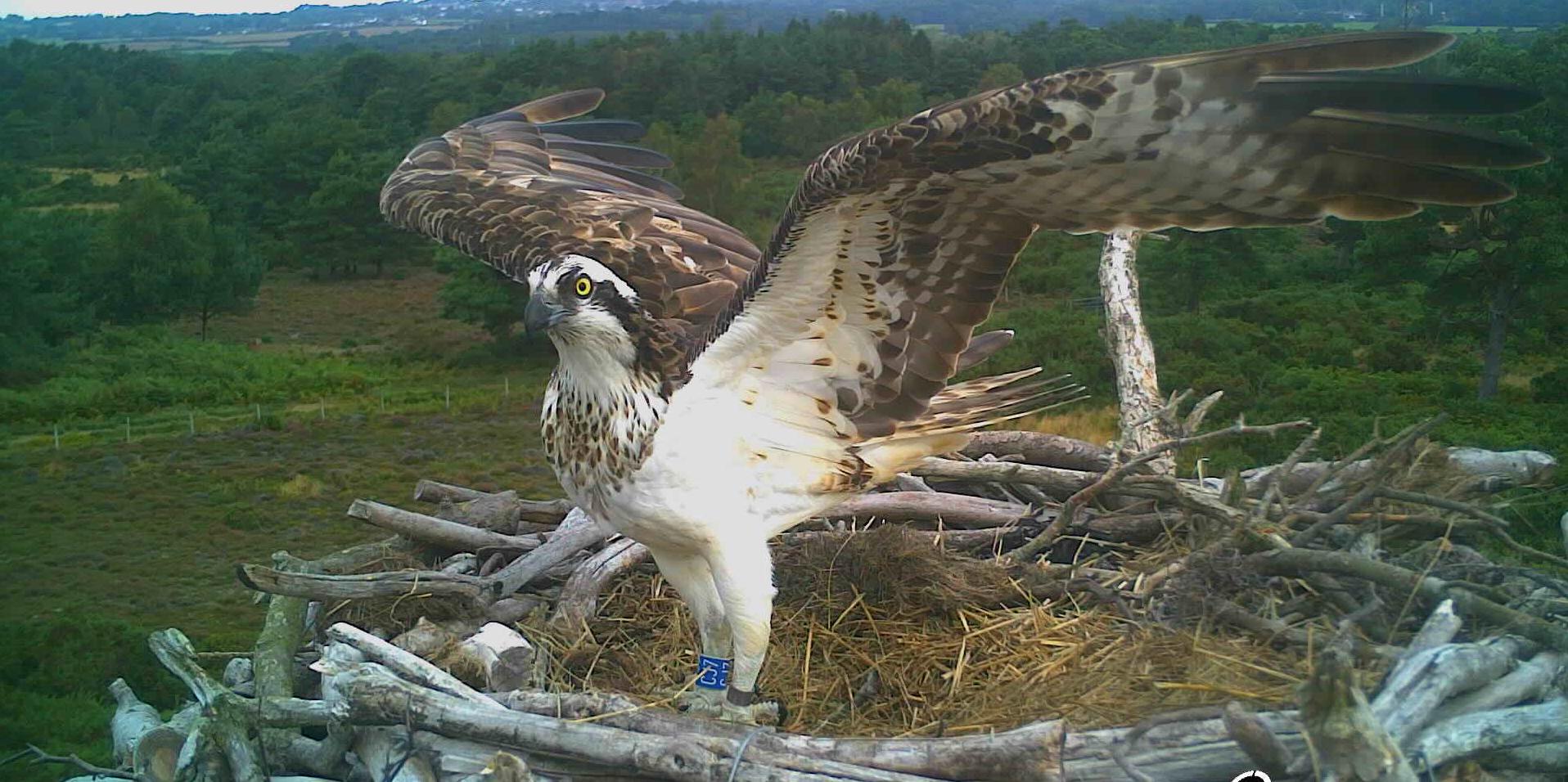
Oystercatcher
Latin Name
Haematopus ostralegus
Status
Resident
Site And Records Information
Poole Harbour is the premier area in Dorset for this species. Can often be seen feeding on any mudflat or shingle beach around the harbour, especially in winter. The main high tide roost is on Brownsea lagoon, often with 800+ present and large gatherings of up to 300-400 can be viewed on the shingle bank at Shipstal. Feeding also takes place on the Baiter Park, the football pitches at Whitecliff despite many dogs and on the sports pitches on the south side of Lytchett Bay. Poole Harbour is the main breeding area in Dorset with the bulk of the population historically nesting on Brownsea. Numbers have fluctuated considerably from year to year with a maximum of c40 pairs in 1978, However the numbers of pairs have been in decline over the years, with a range of 5 – 26 per year up to 2006.
A county record was broken with a count of 2034 in Dec 1999. Since then peak numbers have declined and the mean peak count between 2015 and 2019 is now only 955. This reflects a recent trend whereby numbers peak on autumn migration rather than in winter.
While not of national importance Poole Harbour is one of the largest wintering areas on the south coast and a busy terminus for passage birds. In September the first batch of birds arrive, after breeding in Iceland, Scotland, and the north of England. Then as winter progresses Norwegian birds filter down the east coast, adding to the population which peaks between November and January. Robin Ward worked a lot of this out and wrote in the 1989 Dorset bird report that; “the relatively slow fall in numbers of Poole’s Oystercatcher numbers during March is indicative of the presence of Norwegian breeding birds”. His hypotheses were made from a substantial ringing programme during which Britain’s only recovery of an Oystercatcher ringed in Poole and recovered in Greenland was made. He also stated that “over 1500 birds have been ringed in the harbour by Chris Reynolds and Alan Bromby.” A 2nd cal year Oystercatcher was ringed on Brownsea in November 1999 and recovered at Seine France in August 1999. Another was ringed in March 1998 and controlled from Manche, France in July 1999. The longest lived in the harbour was one that was ringed on Brownsea in 1975 and finally found dead tangled in nylon fishing wire also in the harbour 24 years later in November 1999.
All this activity means that we can reckon on 200 to 300 local birds that stay around, many immature, some breeding, and that the winter balance of a thousand to fifteen hundred are migrants.
The last full survey of the breeding birds by McClure and Payne in 1994 showed that the Oystercatchers preferred breeding on the islands around the harbour with at least 25 pairs, most on Brownsea. They stated that“ 7 pairs on Furzey in 1985 and 1994′. Pickess and Day believed this was still the case, and calculated an average of 16 pairs. There were 27 pairs on Brownsea in 2004, but no recent Poole Harbour breeding Oystercatcher surveys has been conducted.
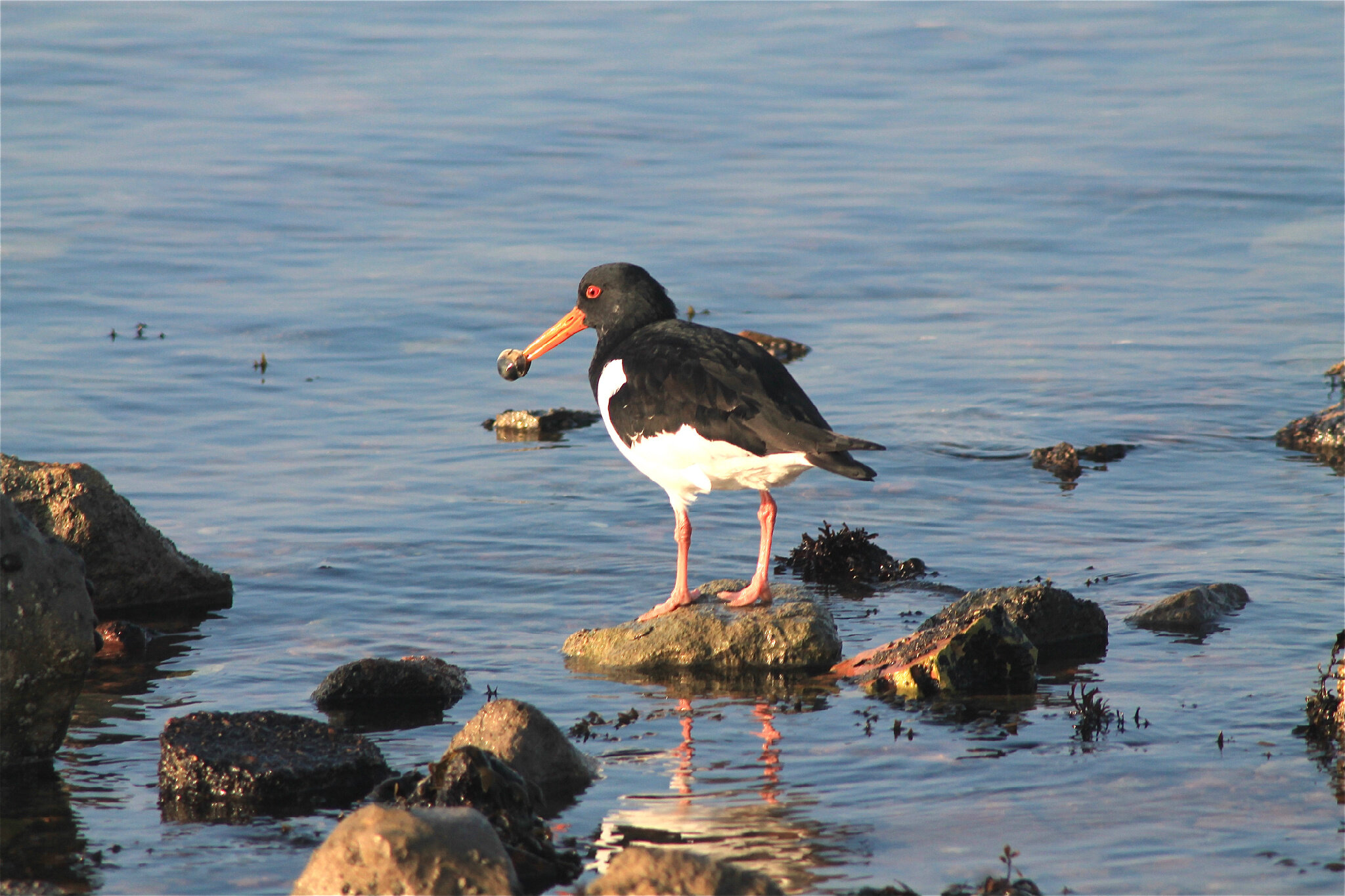
Call 01202 641 003
© 2025 Birds of Poole Harbour Registered Charity No. 1152615

